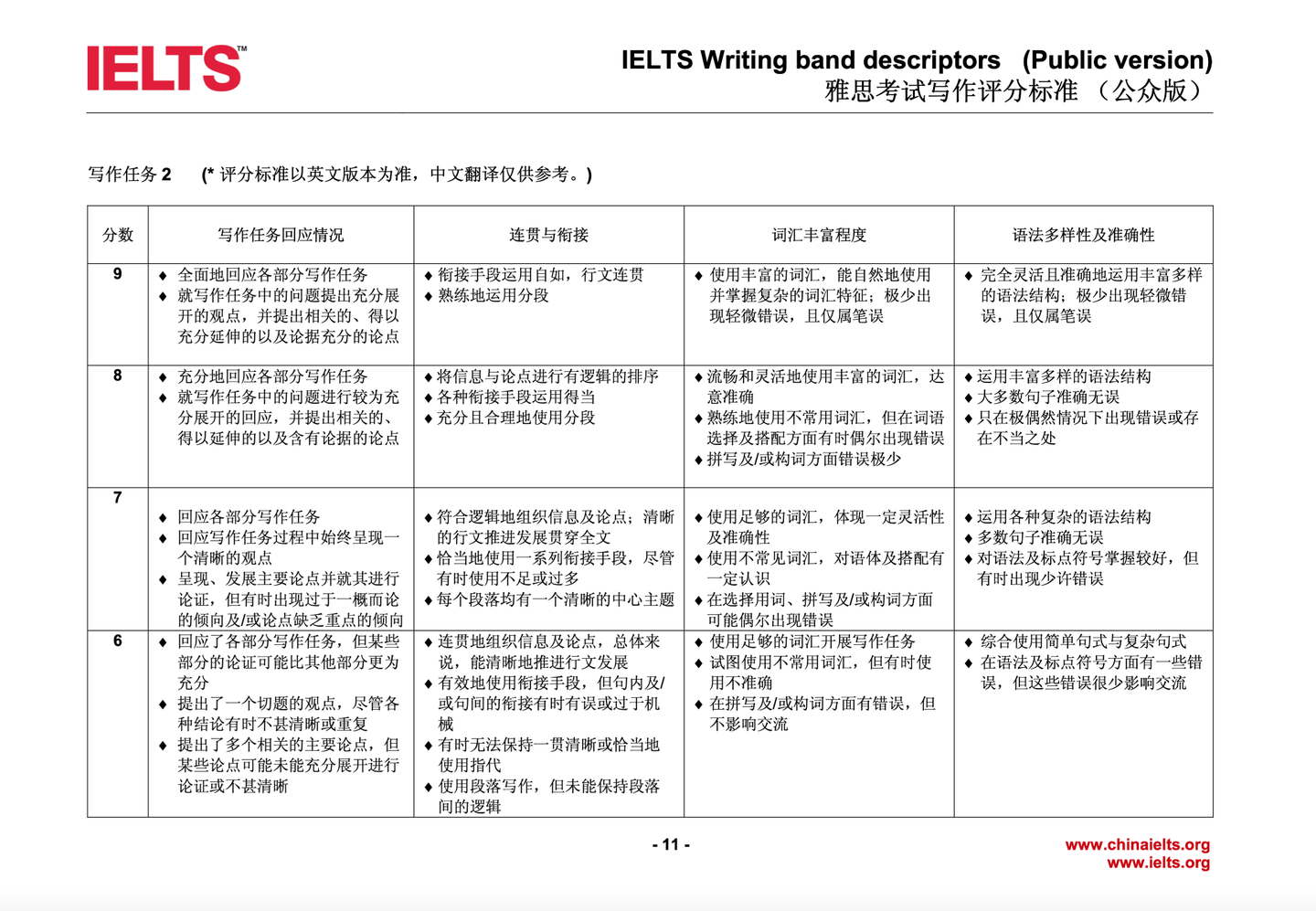I have also experienced this bottleneck, stuck at 6.5 and unable to reach 7. Below are the pitfalls and coping methods I encountered when breaking through the bottleneck to 8, which will definitely help you break through this bottleneck.
1. The biggest difference between the judging criteria of 6 and 7
Only after you understand the rules of the game can you play it, so let’s first take a look at the scoring criteria for IELTS essays.

In this standard, you can actually see that there are many "partial", "sometimes unclear", "some errors", and "does not affect communication" in the 6-point standard. In fact, we can basically conclude that the characteristics of a 6-point essay are that the logical structure is OK, there can be sentence errors, but as long as you can understand it, it's fine.
Let's look at the score again. The key words are "clear", "occasionally wrong", and "accurate", so the main requirements for 7 points are: the logical structure is clear and clear, and most of the sentences are correct (no more than 3). Look carefully, it doesn't say whether it is a high-level grammar error, a word error, or a punctuation error. Anyway, as long as it is wrong, it is wrong.
2. Common pitfalls
1. Essays vs. Academic Writing
This is mainly aimed at the logical structure. In fact, many of them talk about great principles at a very high level, but the content of the discussion feels floating, without a specific structure, similar to prose. Among the fans I have helped, beginners make this mistake more often. Here is a simple example:
This is the first sentence of the second paragraph of the essay on why people like to know the history of their houses. To begin with, Every country has many stories and a rich history to offer, but it all depends on an individual to what extend one is curious to know about it. The problem is that the first sentence should be the central sentence, but this sentence does not put forward any specific arguments to support the theme, making the article feel scattered.
2. Show off your grammar
This pit is often dug by English teachers, who use all the grammar you know, regardless of whether it is appropriate or not. The first sentence is a participle adverbial, the second sentence is an independent subject structure, the third sentence is an emphatic sentence, and the fourth sentence is a quadruple clause nesting doll. Excessive abuse of complex grammar is not only not used in daily life, but also easy to make mistakes, a typical example is multiple nesting dolls.
When I was studying abroad, there were so many academic discussions, but to be honest, I never used the independent subject structure. If you read some high-scoring examples, you will find that the grammar they use is what people usually use when speaking, and there is nothing particularly "pretentious". In fact, we should use simple sentences and complex sentences reasonably: simple sentences: short and concise, memorable; complex sentences, rich and accurate in meaning.
3. Connective word catchphrase
Many of these are bad habits brought over from Chinese, such as using "but" regardless of whether there is a logical transition or not, and using "so" regardless of whether there is a causal relationship or not. Such problems may not seem like a big deal in spoken language, but in fact, they will disrupt the logic of the article in writing and make it more difficult for your readers to read.
4. Chinese punctuation and sentence segmentation
Punctuation and sentence segmentation in Chinese are very different from English. Chinese sentence segmentation is relatively casual, while English is strict, one sentence per meaning. This difference causes some students to constantly use commas and not break sentences. This may not seem like a big deal, but it is actually a big problem: it causes incorrect sentences. Do you remember the standard of 7 points? Most sentences are correct. So this can easily say goodbye to 7 points.
5. Look down on small grammar
I have made this kind of mistakes, such as the definite article the, singular and plural, and the unity of time. I think it is actually a small mistake. But this kind of mistake is the same as the punctuation mistake. It is easy to make mistakes and easy to be ignored. Although it generally does not make people unable to understand the meaning of your sentence, it also causes errors in the sentence, which does not meet the standard of "often error-free sentences" of 7 points.
Don’t underestimate these small grammatical errors. As a native language, Chinese will sometimes make mistakes. As a second foreign language, it is also common to make mistakes frequently.
3. Solutions you can try
How many of the above pitfalls have you fallen into? Some friends may not know which pitfalls they have fallen into, so you may need to find a study partner or teacher to help you review your essays. Practice makes perfect. Find out your mistakes and correct them in a targeted way to make progress. Otherwise, no matter how much you practice, it will be useless.
1. Find a study partner or teacher to help you grade your essays
The author has already done this. In an essay with a score of about 6, the first thing to solve is the problem of "most sentences are correct" in the 7-point standard. However, your sentences "do not delay communication" and can be understood, so it can be seen that most of the problems are minor. However, it is difficult to find the problem of such minor problems by yourself, mainly because of subjectivity.
I was like this before. A similar classmate pointed out the problem with the definite article "the" to me a few years ago. But when I met my previous teacher for guidance and he corrected the characters, he found the mistake again and I faced it.
The important thing is not to mark the essay, but to count which mistakes you made after being marked by others, and to make statistics and categories, such as definite articles, singular and plural, states of affairs, spelling, sentence segmentation, vocabulary accuracy, etc. You can mark the correct words and see which ones are the most, so as to prepare for the later review.

2. Write an outline quickly
The next two points are to ensure the correctness of the writing process. The outline step can help you find many problems and difficulties in logic and arguments (examples). Before writing, you must spend about 1-2 minutes to simply write an outline, think about the thesis, sub-thesis, and what the arguments are. In this way, the problem of logical structure can be solved.
Imagine if you have spent 20 minutes writing and then change the logical structure, or find that a sub-point is a bit off topic, then you will be at a loss, because you can't make changes during the exam. So sharpening the knife does not delay the chopping of wood. Allocating 1-2 minutes to write an outline can achieve twice the result with half the effort.
3. Leave time for review
This is also a writing process, but it requires you to cooperate with other people's corrections before you, so that you can understand where you often make mistakes. Therefore, when reviewing, you will have a certain preconceived advantage and can spend more energy on those places where you often make mistakes, so that more sentences become error-free.
When doing it, read it silently from the beginning to the end, and pay more attention to the mistakes you made. For example, if you always make mistakes with definite articles, pay more attention to nouns, because many of them are preceded by definite articles. You must practice reviewing this step when writing, usually for about 3 minutes. Only after you have corrected it yourself and found the mistakes, can you really correct it yourself during the exam. Otherwise, you will be very subjective and think that what you wrote is perfect. (But in most cases it is not)

4. Count and improve your mistakes during practice
Similar to method 1, after others give you feedback, you should also do statistics every time you review it so that you can see the changes. If one problem is really reduced, you can adjust your attention to the second and third errors in real time.
Knowing the mistakes and finding the correct method, you can check the grammar book "Cambridge IELTS Grammar》, or other more strict grammars, which are not recommended here. Don't focus on too many at a time, just focus on the grammars that are wrong in the top three, otherwise you won't be able to remember them.
5. Practice simple sentences, complex sentences, and compound sentences
In addition to the small grammar mistakes you made, you should also be familiar with the three different types of sentence segmentation and judgment in English, as well as the use of punctuation marks, otherwise you will make small mistakes again. This exercise is recommended to be done as follows:
1. Think clearly about what this paragraph of flowers means.
2. Then split it into simple sentences according to the subject, predicate and object group.
3. Then see how several simple sentences can be combined to form complex or compound sentences.
for example:
The idea is: Protecting the environment is not only the work of the government, but also everyone's responsibility, because we do not have a second chance. Divide it into 3 simple sentences: 1. Protecting the environment is not only the work of the government. 2. It is also the duty of everyone. 3. We do not have the second chance. Finally, combine it into a more complex sentence: Environment protection is not only the work of the government but also the duty of everybody because we do not have the second chance.
It will be slow to break down and group sentences at first, but after becoming familiar with them, you will have a clearer understanding of the sentence structure and the logic of each clause.
I believe these methods can help you improve your writing. Remember that essays with a score of 7 have very few minor mistakes, and most sentences are correct. So find your common mistakes, improve them in a targeted manner, and then use the outline and review steps to ensure that there are fewer mistakes in the process, so that you can reach a higher standard.
During the IELTS Cambridge test taking process, send a private message to Yishan about the difficulties you encounter and the help you need.